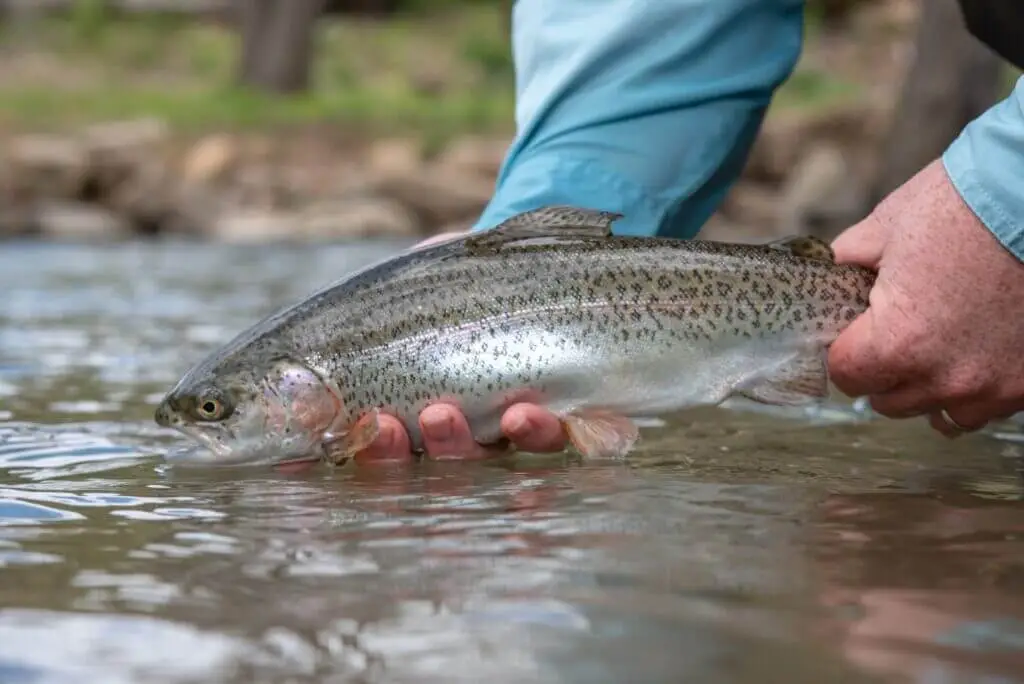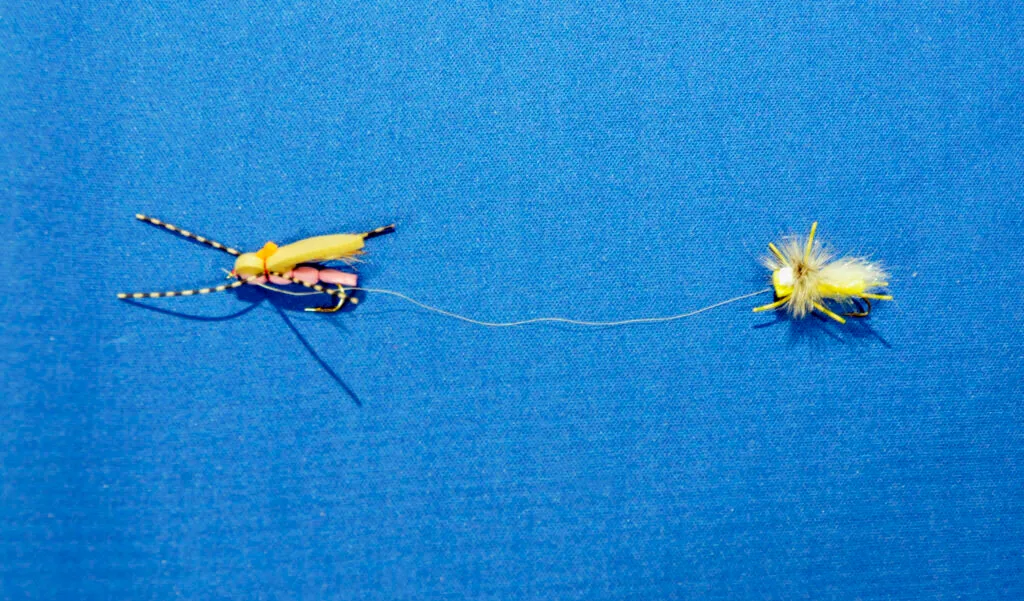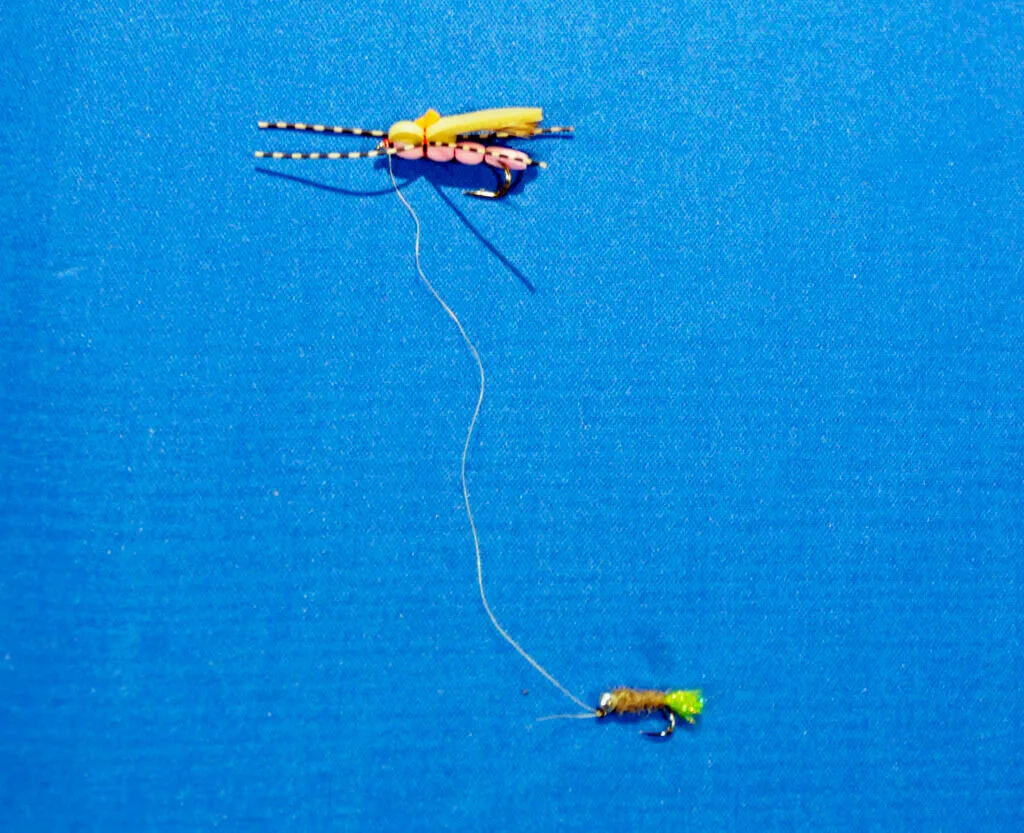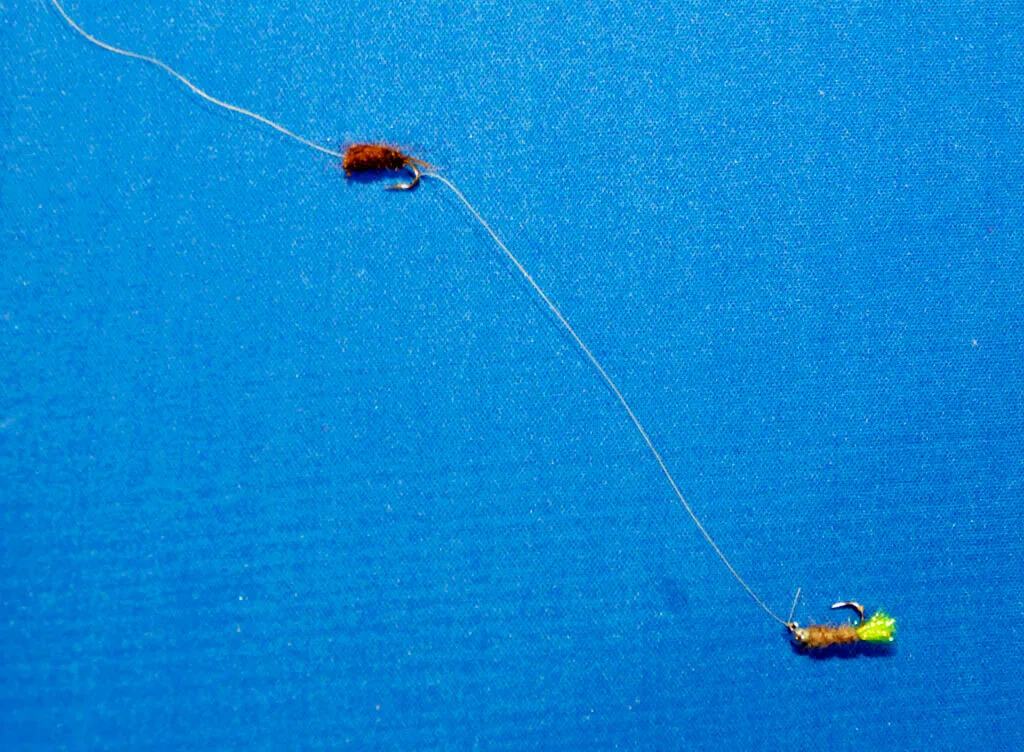Strategies for Fishing Dry-Dropper and Tandem Fly Rigs

Dry dropper and tandem rigs are two popular methods of fly fishing, and while similar, they are not the same. Each has fundamental differences, and therefore requires slightly different techniques to be most effective.
Dry-Dropper and Tandem Rigs Explained
The simple description of a tandem fly rig is one fly tied to a tippet and a second, trailing fly attached by a line between the two flies. A dropper rig is a form of tandem fly rig, but a tandem rig need not include a dropper fly. For instance, two dry flies joined by a leader, floating on the surface is not a dropper rig. The distinction of the dropper fly rig is that the second fly “drops” deeper into the water than the lead fly.
The most common form of a simple tandem rig is two floating imitations tied in line, attached by a section of tippet. Let’s say a lucky fly fisher is on a stream during a major Green Drake hatch. He ties a size 8, floating imitation of a Green Drake to the tippet and then adds a tippet from that fly to a smaller, size 10 imitation. The reason he might cast this tandem fly rig is to determine which size fly is most appealing to the fish, and eventually switch to the fly that fish prefer more.
There is a technical difference between a dry-dropper fly rig and a hopper-dropper fly rig, but in this case, we shall refer to both as dry-dropper rigs because both include a lead fly that floats on the surface.

Fishing the Dry-Dropper Rig
Dry-dropper rigs are most publicized and therefore come to mind for most fly fishers when they imagine a dropper fly rig. Dry-dropper rigs are particularly useful when trout are occasionally, but not continuously, rising to the surface. This rig gives fishermen the best chance of luring fish feeding near the bottom as well as those feeding on the surface. This rig also comes in handy when water levels are low and clear, when the current is too soft to effectively Euronymph and using an indicator might spook fish. Essentially, the dry fly serves as a very natural indicator that also offers another chance to catch trout.
A key challenge when using a dry-dropper rig is caused by the speed of the current at the surface, which is faster than the current below. Essentially, the dry fly will be moving so fast that it drags the trailing nymph up and out of the lower current’s strike zone. There are a few tactics I use to remedy this problem.
First, the trailing nymph should be weighted enough to drift as directly below the lead fly as possible. Nymphs weighted with wire during the fly tying process work well, as do flies with beadheads; I prefer those tied with tungsten beads. Although the fly will still naturally “trail” the lead fly, using heavier nymphs is the first step to a better dry-dropper presentation.

The next step is to use a light tippet to attach the dropper. The smaller the diameter of the line, the better it will slice through the water. But always keep in mind the situation and the fish you’re targeting. For example, a 7x tippet might be a good choice when fishing for stocked rainbows or wild browns, but not a great choice when targeting a voracious, 10-pound steelhead.
Though fluorocarbon is more expensive than monofilament, it can be a great choice for leader material because it is denser, with a stronger breaking strength than monofilament of equivalent size. Fluorocarbon material will allow dropper flies to sink faster and remain deeper during the drift.
A third way to get your dropper fly to position directly under the dry fly is to throw a big upstream mend into the line as soon as the rig hits the water. This will allow the dropper to sink into position before the rig begins its downstream drift.
When choosing flies to make up a dry-dropper rig, bear in mind that a well-thought-out, balanced rig works best. The natural tendency is to increase the size of the dry fly to support a heavier nymph. That can be a mistake! Due to its larger size and increased buoyancy, the current will drag the larger dry fly even more rapidly, which in turn lifts the trailing nymph. Do not lose sight of the goal, which is to cast two flies that equally appeal to the fish. Avoid overreaction and the decision to increase the size of the dry fly so it is no longer desired by the fish.

Fishing the Tandem Fly Rig
Some fly fishers assume that a dropper rig always includes a dry fly, but that is not true. Any time two flies are tied in tandem, and the rear imitation drifts lower than the lead imitation, it is considered a dropper rig. Why create such a rig? Perhaps the fisherman is fishing in 3 feet of water and notices trout hugging the bottom and several suspended fish feeding just below the surface. He may find it worthwhile to create a rig that drifts nymphs through both strike zones. One way to reach these fish is with a tandem rig, and in this case, I prefer using a lighter or non-weighted nymph at the front and a weighted nymph drifting near the bottom.
Note that even though both flies are submerged, they are still affected by water currents moving at different speeds. As a rule, the surface current is the fastest, and the mid-depth current is slower but still faster than the current at the lowest depth.
Every fly fishing fanatic has a personal preference for the distance between flies. My “usual” preference is 15 to 18 inches for most situations, but it can be a mistake to have a predetermined length in mind. Spacing is best decided and adjusted according to several factors that must be witnessed on the stream. Those factors include, but are not limited to, water flow, stream obstacles, streamside obstructions, and observed fish activity.
Challenges of Fishing A Two-Fly Rig
The use of two flies will present some nuisances that must be considered. These negatives include the increased likelihood of experiencing wind knots, snags with netting, and foul-hooked fish. Each person must weigh the potential to increase their catch versus the challenges caused by circumstances and proceed accordingly.
Once you’ve tied on a point fly, or lead fly, there are three common ways to create a tandem rig. The first is to attach the dropper with a section of tippet tied to the eye of the point fly. The second is to attach a dropper with a section of tippet tied directly to the bend of the point fly. The third is to tie the dropper to the tippet above the point fly. Each of these methods has positives and negatives, depending on the person using them.
Fans of tying the leader to the first fly’s eyelet claim that allows the front fly to hold fish better. They believe that if a trailing fly is attached to the bend of the first fly’s hook, and the trailing fly gets hung up on an obstacle while playing a fish, even briefly, the leader will cause the first fly to tip and twist, nearly duplicating the action an angler using forceps to remove the hook from the fish. This concern is heightened if barbless hooks are used. Many believe the tippet could potentially slip off of a barbless hook much easier if tied to the bend of the point fly.
Those who prefer tying the leader to the bend of the first fly’s hook say it is difficult enough to thread one tippet through a hook’s eyelet without adding the challenge of feeding a second line through the same eyelet. They also believe there is a greater chance the two flies will entangle because the tippet between the two flies is more apt to brush against the hackle of a leading, dry fly during the process of casting.
And there are those who prefer tying the dropper nymph in above the point fly using a triple surgeons knot. While technically not a “dropper,” the same effect is achieved with this method; you’re still fishing two two flies at multiple levels in the water column. Similar to the other two methods of attaching a dropper, there’s always the chance, and likelihood, of the flies tangling while casting.
Regardless of how you choose to attach the dropper fly to the point fly, a rig consisting of two flies increases the chances of snagging obstacles. Because it is usually the trailing imitation that gets snagged, I typically attach the dropper nymph using tippet that is at least one size lighter than the tippet used above the point fly. Hopefully, as I try to free the flies, the weaker tippet breaks first and I can salvage my point fly. I’d much rather surrender one fly than two!
Did You Find These Dry-Dropper and Tandem Fly Rig Strategies Helpful?
Stay up to date with the Dark Skies Fly Fishing monthly newsletter for free and receive the latest posts in fly fishing tricks, tips, and techniques, news, stream reports, as well as updates on new flies added to the Online Store and exclusive discounts!
Sign Up Now

As always, a well written, in an understandable form, article. Good job Ralph!
Thanks for reading, sir! This particular article was written by my friend Jerry Bush, and I agree, he did an excellent job! My goal on this site is to bring readers the best information possibly by the best writers and fishermen I know, and Jerry is definitely among them!